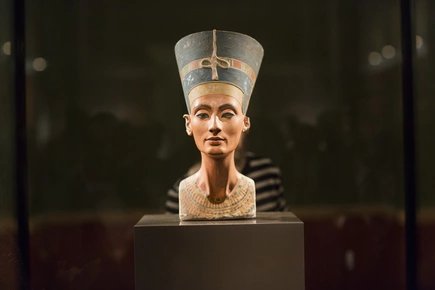
Andreas Scholl, Director of the Collection of Classical Antiquities
My favourite piece from the collections
The "Stele Giustiniani" in the Altes Museum
My personal favourite piece is the Grave Relief of a Girl: The 143 cm high stele was made around 460 BC and you can see it today in Room 7 of the Altes Museum, which is dedicated to the theme of "Life and Death in Classical Athens - Everyday Life in an Ancient Metropolis".
Greek relief art of the highest quality
Since I first saw the famous frieze panels of the Parthenon in the British Museum as a schoolboy, I have been fascinated by the sculptural quality of Greek relief art. In the Berlin Collection of Classical Antiquities in particular, its development from the 6th to the 1st century BC can be traced in outstanding examples. One of the undoubtedly most beautiful examples is the stele Giustiniani, named after its previous owner.

The epitome of classical beauty
This slender funerary stele depicts a girl with her head bowed in a high field with a narrow frame. Her robe made of heavy woollen fabric was originally held together on the right shoulder with a clasp set in bronze. The ears were also adorned with bronze and probably gold-plated pendants. In her left hand, the girl, who died far too young, holds a round container, the lid of which is on the ground in front of her. With her right hand, she removes an originally painted piece of jewellery or a bandage, but perhaps also grains of incense for sacrifice. A splendidly unfurling palmette fan serves as the tomb's crowning finial, the calyx of which is formed here for the first time on a Greek funerary stele from acanthus leaves. Such vegetal ornamental elements of Greek tombs, which later became frequent, are not thoughtless decorative ornaments, but symbolise the ever-renewing life in nature.
Elegiacal mood of quiet mourning
An elegiac mood of quiet mourning lies over the image of the girl as an overly clear reference to her all too early death. Nothing seemed more terrible to the ancient Greeks than an end to life before marriage, and particularly expensive and artistically ambitious tombs were often erected for those who died unmarried. The type of relief and the sculptural style, the material, soft and heavy rendering of the garment and the lush vegetal growth of the ornament indicate that this impressive tomb of a Greek girl was created around 460 BC by a sculptor from the Cycladic island of Paros.
Prof. Dr. Andreas Scholl
